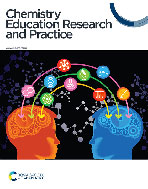Measuring student motivation in foundation-level inorganic chemistry courses: a multi-institution study
Abstract
The association between student motivation and learning, and changes in motivation across a course, were evaluated for students enrolled in one-semester foundation-level inorganic chemistry courses at multiple postsecondary institutions across the United States. The Academic Motivation Scale for Chemistry (AMS-Chemistry) and the Foundations of Inorganic Chemistry American Chemical Society Exam (i.e., a content knowledge measure) were used in this study. Evidence of validity, reliability, and longitudinal measurement invariance for data obtained from the AMS-Chemistry instrument with this population were found using methodologies appropriate for ordinal, non-parametric data. Positive and significant associations between intrinsic motivation measures and academic performance corroborate theoretical and empirical investigations; however, a lack of pre/post changes in motivation suggest that motivation may be less malleable in courses primarily populated by chemistry majors. Implications for inorganic chemistry instructors include paths for incorporating engaging pedagogies known to promote intrinsic motivation and methods for incorporating affect measures into assessment practices. Implications for researchers include a need for more work that disaggregates chemistry majors when evaluating relationships between affect and learning, and when making pre/post comparisons. Additionally, this work provides an example of how to implement more appropriate methods for treating data in studies using Likert-type responses and nested data.


 Please wait while we load your content...
Please wait while we load your content...